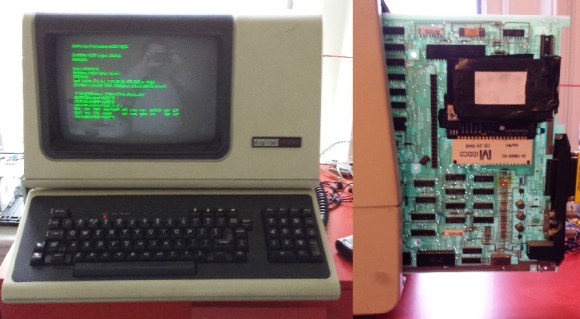
How do you make a great terminal even better? The answer is simple: add a BeagleBone Black to it! [Brendan] got his hands on one of the staples of classic computing, the DEC VT100 terminal. The VT100 was produced from 1978 to 1983. The terminal was so widely used that it became the standard for other terminals to emulate. Open any terminal program today and chances are you’ll find a setting for VT100 emulation.
[Brendan] originally hooked his terminal up to a laptop running Linux. The terminal, cables, and the laptop itself became quite a bit to manage on a small desk. To combat this he decided to add a BeagleBone Black inside the terminal case. It turns out the VT100 actually lends itself to this with its Standard Terminal Port (STP) connector. The STP was designed to add a “paddle board” in-line with the serial stream of the terminal. DEC and third party manufacturers used this port to add everything from disk drives to entire CPM computers to the VT100.
[Brendan] began by designing a board to interface between the VT100 and the BeagleBone. The board level shifts serial lines from the BeagleBone to the VT100. The STP also allows the terminal to provide power to the BeagleBone Black. He did notice some power glitches as the supply of the VT100 came up. This was solved with a standard TI TL77xx voltage supervisor chip. The hardest part of the entire design was the card edge connector for the STP. [Brendan] nailed the dimensions on the first try. In the end [Brendan] was rewarded with a very clean installation that didn’t require any modification to a classic piece of hardware.
We should note that most PCB houses use Electroless Nickel Immersion Gold (ENIG) as their standard coating. This will work for a card edge connector that will be plugged in and removed a few times. Cards that will be inserted and removed often (such as classic console cartridges) will quickly scrape the ENIG coating off. Electroplated Gold over Nickel is the classically accepted material for card edge connectors, however the process most likely is not going to come cheap in hobbyist quantities.
















This is really sweet,I can hardly wait till he gets WiFi running in it.And who else thinks this is what a computer is supposed to look like (even though it it just a terminal.)
Oh lawd the pun in the title – almost gave me a brownout.
Anyone notice the typo (maybe?) on the adapter board?
“BeagleBone Add-On For
For DEC VT100”
http://www.brendanp.com/content/images/2013/Oct/V1_Board.jpg
No a computer is supposed to look like the 10U rack Cromemco computer I have that has 3 Wyse 60’s attached to it.
Computer inside the terminal, you young kids and your strange ideas.
There was a variant of the VT100 that had an LSI-11 SBC built-in, making it a self-contained PDP-11.
Those Beaglebones are so portable! All you need is a VT100 terminal and this adapter board.
Is it really that hard to make a +/- 12V compatible RS232 adapter board? I’m guessing that if all you want is a terminal, you could hack an old laptop to do the same job.
Now just install SIMH and you have a VAX, PDP-11 or PDP-8.
Nooooo….a computer is supposed to look like a Tandy T-1000 (radioshack)…lol. My favorite computer design to date.
Best looking “Home computer” ever was the Amiga 1000. The Mindset might be the winner in some eyes but they were rare.
A computer is supposed to be a set of tall rack cabinets with loud fans, located in a room with a raised floor and tiles that go clank when you step on them.
Is that the original CRT? I’ve seen hundreds of VT100s and this is the first one I’ve encountered with a green screen. They also used the 20 mA current loop interface. This was a big advantage over RS-232, current loop works over very long distances so the terminals could be located remotely. With lightning arrestors you could string wires between buildings and put terminals all over the place. The DEC field service warranty did not cover lightning damage.
I’m pretty sure the CRT is original. When I got the terminal, I had to adjust the alignment of the CRT, and it matched one of the models in the manual. There were a couple different CRTs used, so it’s possible that some are green, and some are not.
From memory, the choices were green, white or amber for most DEC VDU CRTs.
Article title gave me some interesting visuals.
Is there some process that can be done at home to reinforce the ENIG
edge connector so it can be used frequently?
I’ve been needing something to keep my Raspberry Pi steady, since the cables outweigh the computer. My QVT-102 terminal might make a good case for it.
I personally liked the VT340+, 16 colors, backwards compatible with the earlier DEC terminals and it has ReGIS and Sixel graphics support. Back in the late 90’s I had a uVax 3600 running NetBSD, drawing a 800×400 Sixel (bitmap) image was *slow* took a good minute and a half. I never got around to messing with ReGIS (vector) graphics or the mouse support.
But does it run rogue?
why not some wifi board over serial and write a driver for CP/M? As real as it gets with network interaction